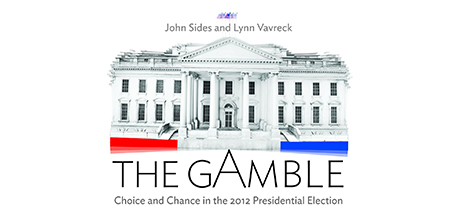In “The Gamble,” Associate Professor of Political Science John Sides and University of California, Los Angeles Professor Lynn Vavreck take a deep dive into what really happened in the 2012 election.
Dr. Sides, the co-founder of the award-winning political science blog “The Monkey Cage,” has written extensively about campaign strategy and voter turnout. In this new book, he and Dr. Vavreck combine narratives about the election with quantitative data and statistics to provide a political scientist’s perspective on how and why Barack Obama was reelected.
The book, which was recently released, has received praise from the Los Angeles Times, the New Yorker and the Washington Post’s Ezra Klein. George Washington Today talked to Dr. Sides about the methods involved in producing the book and what he was most surprised to learn throughout the process.
Q: What drove you to write this book? In particular, what about the 2012 election drew you in?
A: We thought that political science did not have enough of a voice in the conversation about elections. During and after elections, journalists typically write the rough drafts of history. We thought that there was room for the perspective of political scientists.
Q: The writing process was incredibly quick. You reported on the election in real-time. Can you talk about the process of turning around a book so quickly and why it was important to do so?
A: It was important because conventional wisdom about an election forms very quickly. We wanted to be engaged during the campaign itself—via blogging and early e-chapter releases from our book—and then produce a printed book quickly. The key to the process was serialization: As the campaign was going on, we were writing chapters and they were peer-reviewed.
Q: Can you discuss the quantitative data you looked at and the methods you used? How were your approaches different than what experts normally use to analyze elections?
A: Journalists typically rely on interviews with people inside the campaigns. This is useful for knowing why decisions were made, but less useful for know whether those decisions had any effect. So we brought together interviews with 45,000 people as well as data on 11,000 media outlets and more than 1 million political ads to figure out how media coverage and campaigning may have shaped voters—alongside the fundamental factors, like the economy, that we know influence election outcomes.
Q: What were some of the things you were most surprised to learn while putting the book together?
A: One surprise was how neatly the election fit with previous political science research and theories. Here were some of the major findings from 2012: During the primary, all of the news coverage and campaigning mattered a lot and helps explain the many fluctuations in the polls. But during the general election, the campaign mattered less. The presidential debates moved the polls but didn't ultimately decide the winner. The general election campaign—the ads, the field operations—certainly influenced voters, but not to such an extent that Obama's winning margin was the result of his superior campaigning. Ultimately, the candidate favored by the underlying economic and political fundamentals—in this case, Obama—ended up winning. All of these things were anticipated by the 60-plus years of academic research on elections.
Q: How do you think (or hope) your research will shape future approaches to election studies?
A: We hope that our book inspires other researchers to try to make a real-time contribution to our understanding of campaigns. I'm not sure we'll have the energy to do it again in 2016!


